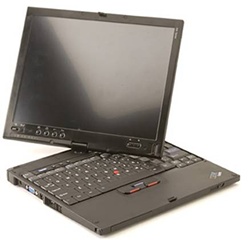EDV:Linux auf Laptops/hardy auf IBM X41 Tablet
IBM X41 Tablet
Standard Features
- Intel Pentium M (Dothan), L2 2 MB cache
- 1.2GHz ULV (753)
- 1.5GHz LV (758)
- 1.6GHz LV (778)
- Intel Graphics Media Accelerator 900
- 12.1" TFT display with 1024x768 resolution
- 256 or 512MB PC2-4200 memory standard (non-removable)
- one additional, unpopulated slot for a maximum of 1280 or 1536MB
- 40 or 60GB Hitachi Travelstar (C4K60 (1.8" drive)) ATA/IDE HDD (Model HTC4260xxG9AT00, where xx stands for the Capacity) producer page
- AD1981B AC'97 Audio controller
- Broadcom Gigabit (10/100/1000) Ethernet controller
- CDC slot with one of the following:
- IBM Integrated 56K Modem (MDC-2)
- IBM Integrated Bluetooth IV with 56K Modem (BMDC-3)
- MiniPCI slot with one of the following:
- IBM 11a/b/g Wireless LAN Mini PCI Adapter II
- Intel PRO/Wireless 2200BG Mini-PCI Adapter
- Intel PRO/Wireless 2915ABG Mini-PCI Adapter
- IBM Embedded Security Subsystem 2.0
- IBM Active Protection System
- SD Card slot with IO support
- CardBus slot (Type 2)
- Integrated Fingerprint Reader on select models
- Wacom Serial Tablet PC Stylus
- Tablet Hardware Buttons
Einige Links
- http://www.thinkwiki.org/wiki/Category:X41_Tablet
- ThinkPad X41Tablet - Hardware Maintenance Manual (March 2006) (7,686,266 Bytes)
- Ubuntu support status page at Ubuntu Wiki
- http://www.thinkwiki.org/wiki/Installing_Ubuntu_6.10_on_a_ThinkPad_X41_Tablet
1. kubuntu hardy installieren
Dazu verwende ich kubuntu-8.04-alternate-i386.iso
Wie immer ist es wichtig danach erst einmal das System zu aktualisieren. In diesem Fall mit 'Adept-Aktualsierer'.
Danach hat sofort funktioniert:
- SD-Karten-Slot
- Grafik (erst mal ...)
- Ethernet-Controller
- WLAN
- Sound
etwas Software
Aktiviere backports und partner in /etc/apt/sources.list
aptitude install openssh-server kedit nedit vim-gtk
Grafik
xorg.conf
Hier ist eine funktionierende xorg.conf:
Section "InputDevice" Identifier "Generic Keyboard" Driver "kbd" Option "XkbRules" "xorg" Option "XkbModel" "pc105" Option "XkbLayout" "de" Option "XkbOptions" "lv3:ralt_switch" EndSection Section "InputDevice" Identifier "Configured Mouse" Driver "mouse" Option "CorePointer" EndSection Section "InputDevice" Identifier "Synaptics Touchpad" Driver "synaptics" Option "SendCoreEvents" "true" Option "Device" "/dev/psaux" Option "Protocol" "auto-dev" Option "HorizEdgeScroll" "0" EndSection Section "InputDevice" Identifier "stylus" Driver "wacom" Option "Device" "/dev/ttyS0" Option "Type" "stylus" Option "ForceDevice" "ISDV4" EndSection Section "InputDevice" Driver "wacom" Identifier "cursor" Option "Device" "/dev/ttyS0" Option "Type" "cursor" Option "ForceDevice" "ISDV4" Option "Mode" "Absolute" Option "TPCButton" "on" EndSection Section "InputDevice" Driver "wacom" Identifier "eraser" Option "Device" "/dev/ttyS0" Option "Type" "eraser" Option "ForceDevice" "ISDV4" EndSection Section "Device" Identifier "Configured Video Device" Boardname "Intel 915" Busid "PCI:0:2:0" Driver "intel" Vendorname "Intel" Option "monitor-TV" "TV" Option "monitor-VGA" "VGA" Option "DRI" "on" EndSection Section "Monitor" Identifier "Configured Monitor" Vendorname "Plug 'n' Play" Modelname "Plug 'n' Play" modeline "640x480@60" 25.2 640 656 752 800 480 490 492 525 -vsync -hsync modeline "800x600@56" 36.0 800 824 896 1024 600 601 603 625 +hsync +vsync modeline "800x600@60" 40.0 800 840 968 1056 600 601 605 628 +hsync +vsync modeline "1024x768@60" 65.0 1024 1048 1184 1344 768 771 777 806 -vsync -hsync Gamma 1.0 Option "DPMS" EndSection Section "Monitor" Identifier "TV" Option "Ignore" "true" EndSection Section "Monitor" Identifier "VGA" Option "Ignore" "false" EndSection Section "Screen" Identifier "Default Screen" Monitor "Configured Monitor" Device "Configured Video Device" Defaultdepth 24 SubSection "Display" Depth 24 Modes "1024x768@60" "800x600@60" "800x600@56" "640x480@60" EndSubSection SubSection "Display" Depth 16 Modes "1024x768@60" "800x600@60" "800x600@56" "640x480@60" EndSubSection EndSection Section "ServerLayout" Identifier "Default Layout" screen 0 "Default Screen" # Inputdevice "Synaptics Touchpad" Inputdevice "cursor" "SendCoreEvents" Inputdevice "stylus" "SendCoreEvents" Inputdevice "eraser" "SendCoreEvents" EndSection Section "Module" Load "glx" Load "GLcore" Load "v4l" EndSection
Wichtig dabei ist:
- ein Touchpad hat der X41 nicht, deshalb ist das auskommentiert.
- Bitte nicht den i810-Treiber verwenden: da funktioniert xrandr nicht und wir haben dann Probleme den externen Beamer/monitor ein- und auszuschalten
- Die 'cursor' 'eraser' 'stylus' - Einträge sind für den Spezialstift des X41 ...
in /usr/share/apps/kxkb/ubuntu.xmodmap hinzufügen:
keycode 139 = XF86RotateWindows
Damit wird der 'Rotate' Knopf definiert
automatisches Schwenken...
#!/bin/sh
#/etc/acpi/x41tsdown.sh
echo 'Rotating screen...'
if [ "`/usr/bin/xrandr -o right -v | grep -i 'randr' | wc -l`" -ne "1" ]
then
echo '!! Something went wrong...'
export DISPLAY=":0.0"
export XAUTHORITY=/var/lib/gdm/\:0.Xauth
/bin/xset -display $DISPLAY dpms
echo 'Trying to rotate again...'
/usr/bin/xrandr -o right
fi
echo 'Rotating stylus...'
/usr/bin/xsetwacom set stylus rotate 1
echo 'Starting keyboard...'
/usr/bin/xvkbd&
#!/bin/sh
#/etc/acpi/x41tsup.sh
echo 'Unrotating screen...'
if [ "`/usr/bin/xrandr -o normal -v | grep -i 'randr' | wc -l`" -ne "1" ]
then
echo '!! Something went wrong...'
export DISPLAY=":0.0"
export XAUTHORITY=/var/lib/gdm/\:0.Xauth
/bin/xset -display $DISPLAY dpms
echo 'Trying to unrotate again...'
/usr/bin/xrandr -o normal
fi
echo 'Rotating stylus...'
/usr/bin/xsetwacom set stylus rotate 0
echo 'Killing keyboard...'
killall xvkbd
Then run:
sudo chown root.root /etc/acpi/x41tsdown.sh sudo chmod 755 /etc/acpi/x41tsdown.sh sudo chown root.root /etc/acpi/x41tsup.sh sudo chmod 755 /etc/acpi/x41tsup.sh
If you'd like to edit these scripts with your favorite text editor (which, I realize, is most likely ed), it's fairly obvious that they're located in /etc/acpi/ as x41tsdown.sh and x41tsup.sh. These commands make the shell scripts that handle the events... once we register the events. Let's do that now.
sudo cat <<EOF > /etc/acpi/events/x41t-swivel-down # /etc/acpi/events/x41t-swivel-down # called when tablet head swivels down event=ibm/hotkey HKEY 00000080 00005009 action=/etc/acpi/x41tsdown.sh EOF
sudo cat <<EOF > /etc/acpi/events/x41t-swivel-up # /etc/acpi/events/x41t-swivel-up # called when tablet head swivels up event=ibm/hotkey HKEY 00000080 0000500a action=/etc/acpi/x41tsup.sh EOF
Now, awaken your inner ACPI daemon with the following commands:
sudo /etc/init.d/acpid force-reload sudo /etc/init.d/acpid restart
And swivel down your LCD to make sure it works.
FingerPrint Sensor
aptitude install thinkfinger-tools libpam-thinkfinger
tf-tool --acquire
Oder auch gleich
tf-tool --acquire /etc/pam_thinkfinger/loginname
um die eingelesenen Abdrücke (bir-Dateien) gleich nach /etc/pam_thinkfinger kopieren zu lassen.
Und in /etc/pam.d/common-auth:
auth sufficient pam_thinkfinger.so auth requisite pam_unix.so nullok_secure #auth optional pam_smbpass.so migrate missingok
AFS
Geht genau wie im Wiki beschrieben
